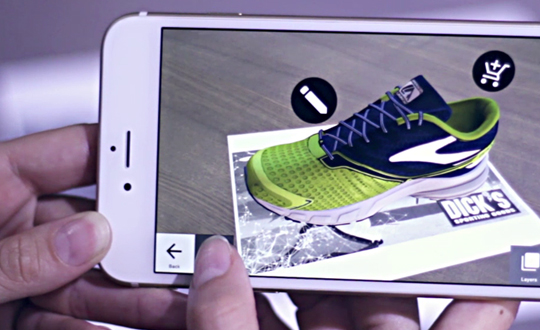
Note: For more information on how retailers are using mixed commerce solutions, check out our Mixed Commerce Glossary, which defines the terminology being used to businesses to describe the changes currently sweeping retail.
Mixed commerce helps turn browsing into buying
Businesses spend millions of dollars each year in an attempt to earn enough customer trust that the shopper will be willing to buy a product online without touching it first. But consumers want to feel the fabric, touch the material, and experience the comfort and quality before they buy.
This is a problem.
Characteristics like “touch” and “feel” are known as “non-digital attributes,” and retailers have relied on them to drive consumers into retail stores for decades. It’s easy to provide product information, sizes, descriptions, price, and more online – but it’s difficult to describe comfort, quality and feel.
But times are changing. Retailers are closing stores at astonishing rates, as consumers aren’t flocking to retail stores like they once did. Even though technology is changing the way people shop, retailers must continue to account for non-digital attributes, and revolutionary solutions now being developed and deployed will ultimately change the way the retail game is played.
Mixed commerce: redefining the shopping experience
Mixed commerce — the blending of the traditional brick and mortar retail store and e-commerce store using augmented and Virtual Reality — unites the consumer’s experience online, in-store and at-home into one confidence-building, awe-inspiring, visual experience. Mixed commerce helps a merchant overcome customer reluctance to making a purchase by creating a cohesive experience throughout the buying journey, helping to eliminate barriers created by a lack of non-digital attributes.
Imagine designing a room using realistic 3D products, interacting and manipulating each item and visualizing the end result in Augmented Reality or Virtual Reality. Now imagine having this experience anywhere you want — at home, at the mall, or within a retailer’s brick-and-mortar storefront. This is what mixed commerce is all about: helping retailers get in front of consumers no matter where or when they shop, while also moving away from costly and limiting showroom space, and driving higher sales per square foot from a smaller location.
We know that experiencing a product, touching it or visualizing an entire remodel gives consumers more confidence. If a person can picture ownership, it significantly increases the likelihood they will make the purchase — just ask any car dealer the next time you’re on a test drive. Augmented and Virtual Reality bridge the gap between real and virtual by allowing consumers to interact with and manipulate an unlimited inventory of realistic 3D models. Add a small number of product samples and a trained concierge as a guide through the experience, and you have a cost-effective way to build confidence and trust in the consumer.
That is the essence of mixed commerce, and it’s already changing the retail landscape.
Mixed commerce in action: The Lowe’s Holoroom
The Lowe’s Holoroom is a great example of a large retailer using mixed commerce to change the way they interact with consumers. The Holoroom allows a shopper to design a new kitchen or bathroom, chock full of realistic 3D models of Lowe’s products, and then step inside the space using an Oculus Rift VR headset. It’s a free and unique shopping experience, which creates interest in the public while also leaving Lowe’s with the ability to showcase every single product they sell without expanding the square footage of their store.
According to the Walker Sands Future of Retail 2016 report, 31% of consumers now shop online at least once a week, compared to 22% in 2014. Nearly ¾ of consumer’s shop online at least once a month. Consumers are attracted to the convenience of browsing an unlimited inventory, and buying quickly and efficiently. Manufacturers and retailers are responding by making e-commerce a core focus of their growth strategy (sometimes it’s the only strategy), but that comes at a high cost.
Here’s another sobering statistic for retailers from Walker Sands: 27% of consumers purchased a luxury item online in the past year, and Millennials are far more comfortable buying products online without touching them. This means that retails sales are ripe for disruption as the buying power of today’s 20-somethings increases with their generational move into middle age.
So how do today’s merchants survive this retail revolution?
3 ways businesses are building consumer confidence and increasing online sales
1. Free Shipping
Offering free shipping is the most popular strategy for getting consumers to buy without touching. It takes the risk out of the transaction, giving the buyer the confidence to take a chance and make that first purchase. You can see the power of free shipping among fashion retailers, who rely heavily on the allure of free shipping to replace the changing room aspect of the retail experience.
Zappos is a great example: The online shoe retailer has been using free shipping for years to increase sales. Before Zappos, nobody believed you could get consumers to buy shoes online without first sending them into a store to try them on. Zappos thought differently, and offered free overnight/2-day shipping and returns. They even encourage consumers to buy multiple sizes and then keep the ones that fit. This obviously comes at a high cost for Zappos, but it helps customers overcome their reluctance to buy before they try, and Zappos still finds a way to profit despite excess shipping costs.
Wayfair has taken the same concept and applied it to home products like furniture — a category still held back by a mentality that says, “no one will buy a couch without sitting in it first!” Wayfair offers free shipping on all orders over $49, no matter the size of the product. Unlike Zappos, Wayfair doesn’t offer free returns. But as online retailing become more the norm, we see that the consumers desire for convenience will drive them to buy more product categories online — including furniture. Just be sure to read those product reviews before getting a living room set shipped to your house.
2. The Freemium Model
The freemium model has been around for decades in retail. It’s the guy handing out bourbon chicken samples at the mall, or taking you on a test-drive at a car dealership, or spritzing you with cologne or perfume as you walk through a department store. But how do internet retailers get product into the hands of potential customers.
Easy, give it away for free.
Harry’s sells men’s shaving products, and began life as a pure e-commerce-only company. In order to get consumers to try their blades and butters, Harry’s gave them away for free. Just pay a mere $3 shipping, and you’d get a free trial set which included a razor and blade, foaming shave gel, and a travel blade cover. This was a costly strategy, but it worked. Harry’s has recently opened a brick and mortar location in NYC, and the company is now selling their products at Target.
Another example of this strategy at work is The Honest Company, a baby products and personal care company started by Jessica Alba (Yes, that Jessica Alba.) The Honest Company offers free discovery kits for a low $5.95 shipping fee.
3. The virtual try-on
E-commerce companies are using Augmented Reality and Virtual Reality technology to build confidence in their customers and help them make a decision, while also cutting down on the expense of shipping. Home improvement
Warby Parker knew they needed to get glasses on consumers faces, a difficult proposition without retail stores, so they introduced the “virtual try-on.” Using the system, consumers could use their computer’s webcam to “try on” any pair of glasses available on the website. The ability to see the glasses on your face helped customers feel more confident in their decisions and comfortable with purchasing online. Note: Warby Parker has removed virtual try on from their site and is now pushing their home try-on option (free shipping of course).
Don’t need glasses, but you are shopping for some new clothes? Metail is an ecommerce site that developed a unique virtual try-on tool for clothing. The site asks you to create your own “MeModel” — a virtual model of yourself. A consumer can take any clothing item on the site and dress their MeModel. It helps build confidence and know what size to order.










